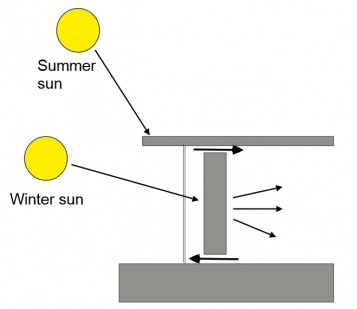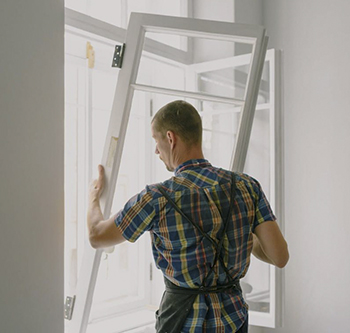Trombe wall
Trombe walls use a combination of thermal mass and glazing to collect and store solar radiation so that it can be used to heat buildings. The broad idea was patented by Edward Morse in 1881, but it was named after French engineer Felix Trombe, who along with architect Jacques Michel used trombe walls as an architectural component in the 1960’s.
A thermally massive wall with good solar absorption characteristics (perhaps with a matt, dark-coloured surface) is orientated facing towards the direction of the sun. The wall is constructed behind a glazed façade that protects it from external conditions. There is generally a space between the glazing and the wall. This space can be very narrow, just sufficient to allow air movement between the glazing and the wall and to provide access for cleaning, or it can be large enough to be habitable.
Solar radiation that penetrates through the glazing will heat up the wall, but the resulting emission of long-wave infrared radiation from the wall will not re-transmit back through the glazing which is opaque to long-wave infrared radiation. This creates an effect similar to that which allows greenhouses to trap solar radiation.
Heat built up in the wall is slowly released into adjacent spaces by radiation and convection. Depending on the thermal mass of the wall, this heat can be released over long periods of time, moderating fluctuations in conditions. This is a form of ‘passive’ solar heating, as opposed to an ‘active’ building services heating system.
The design of trombe walls needs to enable them to provide solar heating during colder periods, but not to generate overheating during warmer periods. This might require the use of external vents, shading or overhanging eaves to limit peak gains and to enable night time cooling.
The design may also include vents at the top and bottom of the wall (which may be controllable or even include mechanical assistance) to allow more rapid heat transfer between the wall and the adjacent space, or it may rely entirely on conduction through the wall. Where vents are included, cooler air from the adjacent space will enter through the lower vent, will be heated by the wall and so will rise, and will then return to the adjacent space through the upper vent. Closing the vents at night will prevent reverse flows occurring and removing heat from the space.
Typically the wall will be 20-40 cm thick, made out of high heat capacity materials such as masonry or concrete (or even containers filled with water), with the absorbed heat taking up to 10 hours to conduct to the interior.
Installations can also include solar thermal systems to generate hot water.
The efficiency of trombe walls can be improved by the use of double glazing with a low-e coating to reduce heat losses to the outside. Low-e coatings reduce the effective emissivity of the surface of glass so that it reflects, rather than absorbs, a higher proportion of long-wave infra-red radiation. Ideally, the glazing should have exterior insulation, shutters or blinds to prevent heat loss during the night.
[edit] Find out more
[edit] Related articles on Designing Buildings Wiki
- Cross ventilation.
- Decrement delay.
- Diaphragm wall.
- Dynamic façade.
- Ground energy options.
- Insulation.
- Low-e glass.
- Natural ventilation.
- Passive building design.
- Passive ventilation.
- Solar chimney.
- Solar thermal systems.
- Stack effect.
- Thermal admittance.
- Thermal labyrinth.
- Thermal mass.
- Types of ventilation.
- Ventilation.
- Wall types.
Featured articles and news
Licensing construction in the UK
As the latest report and proposal to licence builders reaches Parliament.
Building Safety Alliance golden thread guidance
Extensive excel checklist of information with guidance document freely accessible.
Fair Payment Code and other payment initiatives
For fair and late payments, need to work together to add value.
Pre-planning delivery programmes and delay penalties
Proposed for housebuilders in government reform: Speeding Up Build Out.
High street health: converting a building for healthcare uses
The benefits of health centres acting as new anchor sites in the high street.
The Remarkable Pinwill Sisters: from ‘lady woodcarvers’ to professionals. Book review.
Skills gap and investment returns on apprenticeships
ECA welcomes new reports from JTL Training and The Electrotechnical Skills Partnership.
Committee report criticises UK retrofit schemes
CIOB responds to UK’s Energy Security and Net Zero Committee report.
Design and construction industry podcasts
Professional development, practice, the pandemic, platforms and podcasts. Have we missed anything?
C20 Society; Buildings at Risk List 2025
10 more buildings published with updates on the past decade of buildings featured.
Boiler Upgrade Scheme and certifications consultation
Summary of government consultation, closing 11 June 2025.
Deputy editor of AT, Tim Fraser, discusses the newly formed society with its current chair, Chris Halligan MCIAT.
Barratt Lo-E passivhaus standard homes planned enmasse
With an initial 728 Lo-E homes across two sites and many more planned for the future.
Government urged to uphold Warm Homes commitment
ECA and industry bodies write to Government concerning its 13.2 billion Warm Homes manifesto commitment.
From project managers to rising stars, sustainability pioneers and more.
Places of Worship in Britain and Ireland, 1929-1990. Book review.























